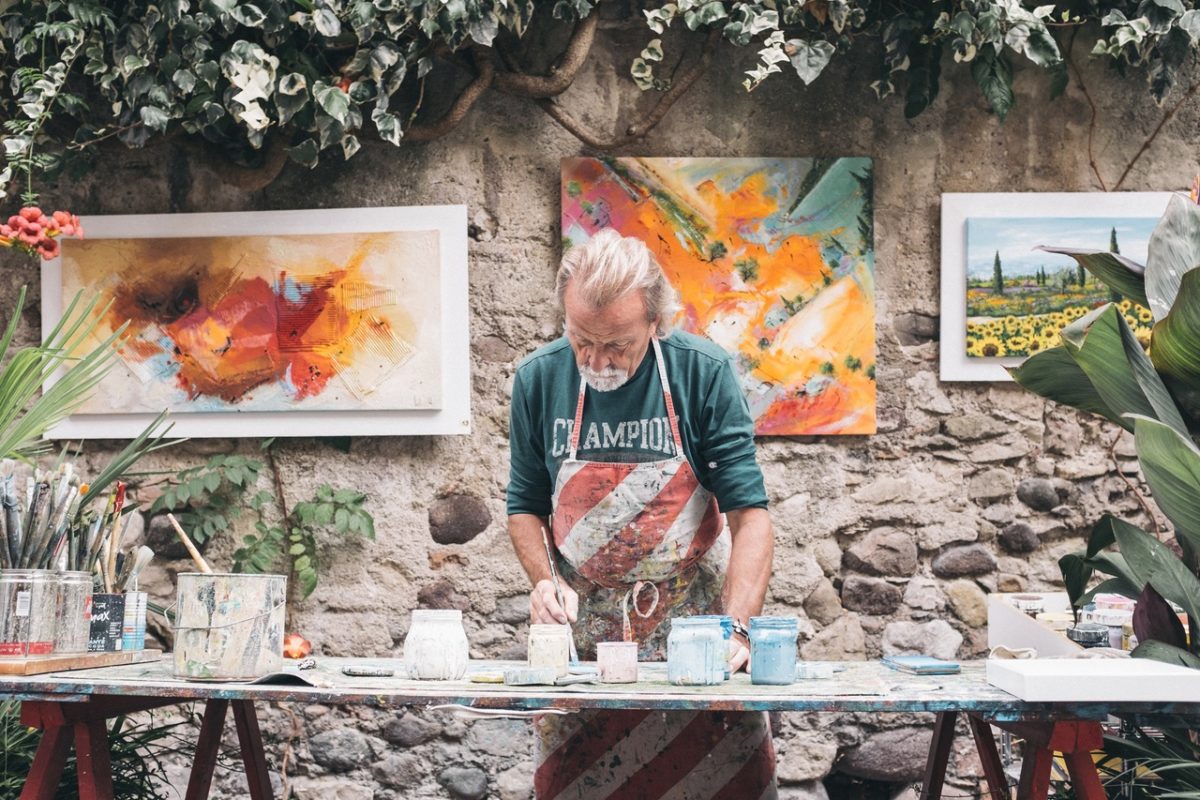James M. Higgins, author of 101 Creative Problem Solving Techniques: The Handbook of New Ideas for Business,defines creativity as the process of generating something new that has value. Creative ideas run the gamut from new associations of existing ideas, elements, or concepts, to radical breakthroughs which extend the boundaries of human knowledge and create paradigm shifts. That is, you don’t necessarily have to make a quantum leap to be creative; you can begin by finding ways to improve an existing product, or by modifying a process to make it more efficient.
Creativity can mean identifying an untapped market for an existing product, finding a new solution to a problem, finding creative ways to resolve a labor dispute, and so on. In addition, creativity is not the sole domain of the arts—whether it’s painting, theatre, music, architecture, dancing, literature, and so on—but is important in any field, from medicine to business, and from engineering to economics.
Also, creativity applies to all facets of life. You can use creativity to solve daily problems and to think of new ways to deal with everyday challenges; you can use creativity to find novel ways to increase your income and finally build your nest egg, you can find creative ways to get your child to go to bed at night, you can be creative when it comes to finding a way to get your employees to arrive at work on time in the mornings, and so on.
Developing your creativity is one of the best things you can do to lead a more satisfying and fulfilling life. Fortunately, as most creativity experts hold – including Jack Foster, Roger von Oech, Edward de Bono, and others – creativity is a process that can be learned, practiced, and perfected. Below you will find four steps you can follow to be more creative. These steps are roughly modeled after the five step technique set forth in the creativity classic, A Technique for Producing Ideas by James Webb Young.
1. Gather Information on Your Subject Matter
The first step involves gathering information about the topic at hand. Read everything you can on your subject matter: go to the library and check out books, go to your neighborhood bookstore and browse though interesting reading material, read magazine articles, subscribe to a newsletter, surf the internet for information, subscribe to blogs dedicated to your topic, and so on. You can also talk to people who have knowledge on the topic and ask them lots of questions, go to a lecture, enroll in a seminar, and even take an online class. The more you know about a topic, the more likely you are to come up with creative ideas for that subject matter.
2. Digest the Information and Apply Creativity Techniques
The second step involves digesting and working with the raw material that you gathered in the previous step. There are many books on creativity which offer the reader different creativity techniques to help in the generation of ideas, and at this point you can begin applying these techniques to your problem. Some creativity techniques are intended to “open your mind” and encourage “free thinking”, such as idea generation and brainstorming sessions, guided imagery, and other expansive techniques. For example, you can begin by releasing all of the preconceived ideas and assumptions you have about the topic and disregard fixed lines of thinking and rigid behavior patterns.
Other techniques create constraints and force your mind to focus, such as setting time deadlines and other methods that force you to converge on a particular course of action. For example, in problem-solving contexts, the random word creativity technique has been shown to produce great results for those who apply it. Basically, a person confronted with a problem is presented with a randomly generated word and is told to make associations between the word and the problem as a creativity goad. By combining expansive and constraining creativity techniques you can come up with several different alternatives to choose from for solving the problem at hand.
3. Take Time for Incubation
The third stage is letting go. You just drop the subject entirely, go do something else, and let the unconscious mind deal with the problem. After a period of intense concentration, Albert Einstein would take a nap or find another way to detach from whatever he was working on. He found that during these mental breaks his unconscious mind would go on thinking about the challenge and surprise him with an insight when he least expected it.
Isaac Asimov was quoted as saying that when he got stuck writing a book he would simply put the project aside and start writing a completely different book. When he returned to the original project he would find that his unconscious mind had figured things out and the ideas would just flow. Therefore, after a period of thinking hard about a problem, the next step is to either work on something entirely different, or to relax: practice deliberate frivolity, go to a museum, go to the movies, or go for a twenty minute walk. Many people have reported “Eureka” moments while taking time for incubation.
4. Refine the Idea and Make it Real
The final stage is where you use trial and experimentation to test, edit, refine and polish the idea. In addition, at this step you need to make your idea real. In her inspiring book, Creative Companion: How to Free Your Creative Spirit, Sark tells the story of an Australian artist named Ken Done who created a painting he thought would look great on bed sheets. He took the idea to a sheet company but they turned him down because they just couldn’t visualize bed sheets with his painting on them. Ken then went home, took a white bed sheet, painted his painting on it, and took it back to the sheet company. The bed sheet he painted looked so fabulous that the sheet company immediately placed a large order. It’s not enough to come up with great ideas, you have to act to turn those ideas into reality.
Conclusion
Begin implementing these steps in all areas of your life, whether it’s your home life, at work, or anything else you’re involved in. In the words of Abraham Maslow: “The key question isn’t ‘What fosters creativity?’ But it is why in God’s name isn’t everyone creative? Where was the human potential lost? How was it crippled? I think therefore a good question might be not why do people create? But why do people not create or innovate? We have got to abandon that sense of amazement in the face of creativity, as if it were a miracle if anybody created anything.






I like the idea of stepping away and letting go. Something we (at least I) don’t always think about. And then making it real – this is the key – to take your creative ideas and turn them into actions. Very thought provoking post – thanks for sharing this!
Lances last blog post..Rain … And Growth
I think the biggest creativity-stifler is our inner critic – the pressure to come up with “something good.” I say we have to take the risk of writing “badly,” or making “bad” art, or coming up with hair-brained business ideas in order to truly unleash our creativity.
I love the steps you outline, especially the “incubation period.” I often get great ideas for blog articles and projects after I’ve spent a day doing home improvement projects.
Blessings,
Andrea
Andrea Hess | Empowered Souls last blog post..Intuition: Setting Short-Term Intentions
I enjoyed your summary of how to encourage creativity, particularly the point you make that we don’t need to always come up with major breakthroughs to class ourselves as creative beings.
Often, we stifle our creativity by our discomfort at taking risks. Many times, well researched and planned ideas never come to fruition simply because we don’t actually try them out. I guess this is linked to the fear of failure which many of us have allowed to develop.
It would be interesting to learn more about how our creativity might also be boosted if we worked on our willingness to take risks.
I have read so much BS on creativity recently that it’s refreshing to read a well written article. Too many people believe you can’t cultivate creativity and that is soooo wrong.
The best part for me is about walking away and not forcing it, that is the key imho. Well that and being open to absolutely anything. During mixed brain storming sessions some of the best ideas come from the (on surface) wackiest suggestions with just a little tinkering. Don’t dismiss anything.
As Edward De Bono says and I’m paraphrasing “it’s not enough to know what lateral thinking is you have to practice it”
Tim Brownsons last blog post..The Maverick Mindset
Indulging in something that truly interests you is the key. If you love it, you will study it… and you find creative, innovative ways to do it better.
Marc and Angel Hack Lifes last blog post..10 Ways to Save 10 Minutes Daily
This beautifully and eloquently article is a wonderful tool to refer to when thinking about what it takes to be creative! There is the creative genius of a blockbuster film to the creative genius of simply making a crying child smile. Both are equally as powerful in the way of showing creativity!
Thank you for sharing some great suggestions to help people find their creative sides AND for quoting one of my favorite gurus, Maslow!
GREAT article!
Dr. KC
http://www.DOCintheBiz.com
http://www.GLCzone.com
I meant to say, “This beautifully and eloquently written article…” Thank you for making this change for me!
Marelisa – I think you might have to re-read my comment. That was exactly my point! If we allow our inner critic to discard all of our creative ideas by judging them, we never get anywhere. I say, let’s have some bad ideas and “failures” (which I like to call unexpected results), rather than never expressing our creativity. As Scott mentions, some risk-taking is required!
Blessings,
Andrea
Andrea Hess | Empowered Souls last blog post..Intuition: Setting Short-Term Intentions
Hi Andrea, I was actually agreeing with you and just developing the point of not being scared to have bad ideas a bit further :-)
Marelisas last blog post..Meditation in Ten Easy Steps
I read somewhere that the times people are most creative are the times when their minds aren’t even focused on the problem they’re trying to solve. For example, I’ve gotten great musical ideas for piano compositions while riding in a car down the highway, and brilliant blog post concepts while I’m taking a shower. :P When you’re free, relaxed, and de-stressed, it’s much, much more easier to be creative, even if you know very little about the topic at hand.
Taking time for incubation truly is essential., yet in our hurried culture, we seem to have lost the ability to take breaks. It’s important to realize that taking a break is not being lazy or abandoning a project. On the contrary: as you point out, it will promote the project by allowing our subconscious to keep working on it.
Vereds last blog post..Not Sure I Am Ready To Be 37
MAN, what a great image up there. Where did you get that? (good article too brother)…
TG
Todds last blog post..24 Hours Of Living ‘In The Flow’
ALSO, I wanted to share something…almost ALL my personal creativity manifests when I am in slilence, or in a state of deep relaxation. I think this speaks to your 3rd point…but creativity is accessible at anytime…it often lies dormant and clutter inhibits us from bringing it into our lives. Sitting silently in nature, meditating, talking a long walk (or drive) and silencing the crazy monkey of the mind allows ALL creativity to come….
tg
Todds last blog post..24 Hours Of Living ‘In The Flow’
Hi Marelisa,
What an informative and educational post on creativity. I like how you put it in four easy steps. This will be a great practice for me to follow in the future.
Thanks for sharing “secrets” that even Albert Einstein and Isaac Asimov used.
Barbara Swaffords last blog post..Step Away From The Blog
Great post. I especially like and agree with incubation point. Many times after studying the begeesus out of a subject and throwing it around a bit, my best thinking about it happens after I’ve walked away from it for a while.
Thanks!
Loraleigh Vances last blog post..7 Surefire Ways to Ignite your Passion
Incubation is key! I tend to take a ton of information, and then wait for it to relate to something in my life so that I can apply personality and passion to it. It takes time, but it’s worth it!
Saras last blog post..Persistence: A Reasonable Stand-in for Perfectionism
Great article, Marelisa. I’ve been working on #3 a lot lately with writings in my blog. I typically type out a bunch of notes for an article and then type it all up.
But recently I’ve been trying to type it up and then let it sit for a bit. Then after awhile, I’ll come back to it and see if any fresh ideas come to me.
These tips work for just about anything. Great article and I stumbled it!
John Hoff – eVentureBizs last blog post..Reading Between The Lines
Great article. Quite useful…
thanks for the info:)